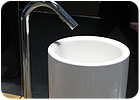A Walk Through ISH 2007

I did the ISH thing again in March, heading over to Frankfurt, Germany, to see what the daddy of all plumbing shows had to excite the hordes this time. For those who have never attended, the biennial ISH Fair doesn’t quite line up with any single show we have here in the U.S. in terms of overall size or product mix. Unlike K/BIS, it includes HVAC and other nonplumbing categories - and also unlike K/BIS, has very little emphasis on kitchen products (except for faucet lines that include them in their overall product offerings). But what plumbing they do have, there is lots of - three large buildings worth.
The
tour I’m about to take you on will give you a brief look at some of the
significant trends and innovations from my perspective - followed by a more detailed
look at one in particular. Here we go:

Untrends
Holding Steady

Trends



The Most Electrifying Trend Of All
In the early 1990s we saw what looked like the beginnings of a movement in electronic faucets and shower valves - only to see it fizzle in short order. Given time to reflect on the failure, we generally concluded that many of those earlier generation offerings were just too complicated and expensive. As someone opined, “To get yourself a glass of water, you had to make a computer entry.”With a number of years to reflect and learn from that false start, industry engineers have developed a new generation of much simpler, intuitive versions. (And our exposure to electronic controls on phones, PDAs, MP3 players and the like during the interval probably sets a better stage for acceptance this time around.) Though there were some hands-free faucets and shower valves shown at ISH, the trend was more in the direction of touch-button systems.

From the standpoint of technologies employed, most touch-button systems appeared to be capacitive (sensing via the conductivity of a user’s fingers) or piezo (sensing minute pressures applied). One manufacturer showed an interesting variation on the four-button theme by connecting touch buttons with lines that you run your finger along to the desired temperature or flow settings. A novel twist from another manufacturer was a faucet with touch buttons located on the pull-out sprayhead.
One of the most innovative designs in the hands-free category was one with a series of infrared sensors positioned around an acrylic disk near the end of the spout. These sensors control the four basic functions without requiring the user to touch the faucet (providing time-regulated adjustments and infinite temperature selection). In addition to water delivery, this faucet also dispensed soap and disinfectant gel.
Looking for a reprint of this article?
From high-res PDFs to custom plaques, order your copy today!




